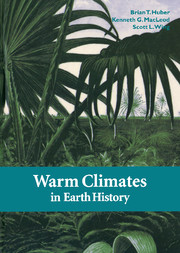Book contents
- Frontmatter
- Contents
- List of contributors
- Preface
- Part 1 Approaches to the study of paleoclimates
- Part II Case studies: latest Paleocene–early Eocene
- 4 Comparison of early Eocene isotopic paleotemperatures and the three-dimensional OGCM temperature field: the potential for use of model-derived surface water δ18O
- 5 Deep-sea environments on a warm earth: latest Paleocene-early Eocene
- 6 Mountains and Eocene climate
- 7 An early Eocene cool period? Evidence for ceontinental cooling during the warmest part of the Cenozoic
- Part III Case studies: Mesozoic
- Part IV Case studies: Paleozoic
- Part V Overview: climate across tectonic timescales
- Index
- Plate section
4 - Comparison of early Eocene isotopic paleotemperatures and the three-dimensional OGCM temperature field: the potential for use of model-derived surface water δ18O
from Part II - Case studies: latest Paleocene–early Eocene
Published online by Cambridge University Press: 06 July 2010
- Frontmatter
- Contents
- List of contributors
- Preface
- Part 1 Approaches to the study of paleoclimates
- Part II Case studies: latest Paleocene–early Eocene
- 4 Comparison of early Eocene isotopic paleotemperatures and the three-dimensional OGCM temperature field: the potential for use of model-derived surface water δ18O
- 5 Deep-sea environments on a warm earth: latest Paleocene-early Eocene
- 6 Mountains and Eocene climate
- 7 An early Eocene cool period? Evidence for ceontinental cooling during the warmest part of the Cenozoic
- Part III Case studies: Mesozoic
- Part IV Case studies: Paleozoic
- Part V Overview: climate across tectonic timescales
- Index
- Plate section
Summary
ABSTRACT
A high-resolution, global simulation of early Eocene (∽ 55 Ma) ocean circulation is described. The Parallel Ocean Climate Model is forced by surface temperature, wind stress, and moisture flux predicted by a GENESIS atmospheric general circulation model simulation with CO2 and oceanic heat transport elevated relative to present-day control values. The ocean model-predicted three-dimensional temperature field is evaluated by comparison against proxy temperature data from benthic and depth-stratified planktonic foraminifera from 28 Deep Sea Drilling Project and Ocean Drilling Program sites. Because of uncertainty in the actual oxygen isotopic composition of early Eocene seawater (δW), two methods of reconstructing surface δW are used: a paleolatitude-dependent relationship based on modern southern hemisphere data and a salinity-dependent relationship based on correlations of salinity and δW across various surface salinity gradients.
Given δW values calculated as a function of paleolatitude and corrected for ice-free global conditions, the model temperatures in the uppermost layer predict the isotopic paleotemperatures from Morozovella within the estimated error (±2°C) in the isotopic paleotemperature equation. The largest mismatch is observed for data from North Atlantic Sites 548 and 550. At all sites except these, the Morozovella paleotemperature falls within the annual temperature cycle simulated by the model. The fit between model and isotopic temperatures is improved for the surface ocean in general and for the North Atlantic in particular when δW is calculated from the model-simulated salinity. However, careful consideration must be given to the choice of an empirical salinity–δw relationship.
- Type
- Chapter
- Information
- Warm Climates in Earth History , pp. 79 - 131Publisher: Cambridge University PressPrint publication year: 1999
- 3
- Cited by



